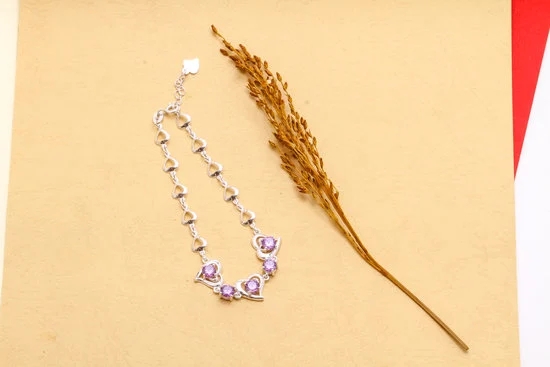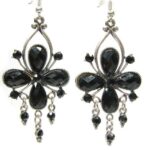Making crystal jewelry with wire has become a popular and trendy DIY hobby in recent years. The beauty and uniqueness of handcrafted crystal wire jewelry have captivated the hearts of jewelry enthusiasts everywhere. In this article, we will delve into why making crystal jewelry with wire is a trending hobby, showcasing its rising popularity, the satisfaction in creating your own pieces, and the allure of handcrafted designs.
In our modern society, where mass-produced jewelry dominates the market, there is a desire for something more personal and one-of-a-kind. Handcrafted crystal wire jewelry provides just that. Each piece is uniquely made by twisting and shaping wires around delicate crystals, resulting in stunning creations that reflect the artist’s individual taste and style. This personal touch adds an element of exclusivity and charm to every piece.
Not only does making crystal jewelry with wire offer the chance to create unique pieces but it also brings immense satisfaction and fulfillment. There is a sense of accomplishment when you see your vision come to life through your hands.
Whether you are creating earrings, pendants, bracelets, or rings, each step of the process allows you to express your creativity and bring beauty into the world. So if you are looking for a hobby that combines artistry, self-expression, and the joy of wearing something truly special, let us guide you through the fascinating world of making crystal jewelry with wire.
Understanding the Basics of Crystal Jewelry Making
When it comes to making crystal jewelry with wire, understanding the basics is crucial for a successful and enjoyable experience. This section will provide you with the necessary tools, materials, and tips to get started on your creative journey.
Firstly, let’s discuss the tools and materials needed for crystal jewelry making. Some essential tools include wire cutters, round nose pliers, chain nose pliers, and a mandrel or ring sizer for sizing rings.
As for materials, you will need craft wire in various gauges and colors, crystals or gemstones of your choice, jump rings, clasps or findings for bracelets and necklaces, and beads or other embellishments if desired. It’s important to have a variety of wire gauges on hand as they serve different purposes in creating different designs.
Next, selecting the right crystals and wires is essential in achieving the desired look for your jewelry pieces. When choosing crystals, consider their metaphysical properties as well as their shape and size. Different shapes like points or tumbled stones can give your piece a unique aesthetic. Additionally, consider the color scheme you want to achieve and how it complements the wire you’ll be using.
Why is wire the preferred medium for crystal jewelry making? Wire offers versatility in terms of design possibilities and durability. It allows you to shape and manipulate intricate designs without compromising strength. Additionally, wire provides a secure structure that holds crystals or gemstones securely in place while showcasing their natural beauty.
By understanding these basics of crystal jewelry making – from tools and materials to selecting crystals and wires – you are well-equipped to embark on your creative journey. Experiment with different combinations to discover your own unique style and create stunning pieces that reflect your personality and taste.
Step-by-Step Guide
Creating wire wrapped crystal pendants is a popular and rewarding craft that allows you to showcase the natural beauty of crystals in a unique and personalized way. This section will provide a step-by-step guide on how to create your own wire wrapped crystal pendant.
Before starting your project, gather the necessary tools and materials. You will need round nose pliers, chain nose pliers, wire cutters, a mandrel or pen barrel for shaping the wire, and wires of different gauges. It is important to choose the right crystals for your pendant based on their size, shape, and personal preference. Good choices for beginners include quartz crystals or tumbled stones with smooth surfaces.
To begin wire wrapping your crystal pendant, start by creating the bail – this is the loop through which your necklace chain or cord will pass. Cut a 6-inch length of wire (18 gauge is common) and use round nose pliers to make a small loop at one end. Hold onto the loop with chain nose pliers as you wrap the remaining length around itself, creating a neat spiral shape.
Next, select another piece of wire (22-24 gauge) about 12 inches long. Slide this wire through the spiral bail you just created until it’s centered between both ends of the bail. Then wrap each end of this wire around its own side of the bail several times to secure it in place.
Once your bail is secure, it’s time to position your crystal within the wire frame. Place your crystal in the center of the frame created by the two parallel wires crossing at right angles where they meet at each side of the bail. Use smaller gauge wires (26-28 gauge) to wrap around these cross points between each arm of your frame and coil them tightly several times.
Finally, trim any excess wire using wire cutters and use chain nose pliers to pinch down any sharp ends that may be sticking out. Give your pendant a final polish with a soft cloth and admire your beautiful wire wrapped crystal pendant.
| Design | Description |
|---|---|
 | A simple yet elegant design featuring a single amethyst crystal wire wrapped in silver. |
 | A more intricate design with multiple wires woven around a rose quartz crystal, creating an eye-catching pattern. |
 | A bohemian-inspired design incorporating colorful beads and gemstones alongside a wire wrapped clear quartz crystal. |
Enhancing Crystal Jewelry with Wire Weaving Techniques
Wire weaving is a method that can elevate the design of crystal jewelry and add a unique touch to each piece. By incorporating different weaving patterns, various effects can be achieved, creating stunning and intricate designs. In this section, we will explore the art of wire weaving and provide step-by-step instructions on how to weave wire around crystals.
Wire weaving involves using multiple wires to create delicate patterns around crystals, enhancing their beauty and giving them a more intricate look. There are different weaving patterns that can be used, such as the over-under weave or the figure-eight weave. Each pattern creates a distinct effect on the overall design of the piece.
To start wire weaving a crystal pendant, begin by selecting your desired crystal and ensure that it has a hole or opening for the wires to pass through. Make sure you have enough wire to work with – typically, 24-gauge or 22-gauge wire works best for this technique.
- Step 1: Cut two equal lengths of wire (around 12 inches each) and slide both through the hole in your crystal pendant.
- Step 2: Hold both ends of the wires together tightly below the pendant.
- Step 3: Begin weaving by crossing one wire over the other and then passing it under both wires.
- Step 4: Pull tight gently on both ends of the wires so that they are snug against the crystal.
- Step 5: Repeat steps 3-4 until you reach your desired woven length.
- Step 6: Once you have completed your desired woven section, twist both wires together to secure them at the bottom of your pendant.
- Step 7: Trim off any excess wire and use pliers to tuck in any rough edges.
By following these instructions, you can create beautifully woven wire pendants that showcase your crystals in an elegant way. Don’t be afraid to experiment with different weaving patterns or incorporate other elements like beads or gemstones into your designs. With wire weaving techniques, you can truly create unique and eye-catching crystal jewelry pieces.
To showcase your wire-wrapped crystal jewelry effectively, it’s important to use high-quality photographs that capture the intricacy of your designs. Find a well-lit area with a neutral background and experiment with different angles and compositions to find the best way to showcase each piece.
Additionally, consider utilizing online platforms to sell your handmade pieces, such as Etsy or Instagram. Take advantage of social media to connect with potential customers and engage in the vibrant community of crystal jewelry enthusiasts.
Remember, the beauty of making crystal jewelry with wire lies not only in the finished product but also in the journey of creation itself. So embrace your creativity, dive into new designs, and enjoy the therapeutic benefits and sense of accomplishment that come with crafting unique wire-wrapped crystal jewelry.
Incorporating Gemstones and Beads in Wire Wrapped Bracelets
Wire wrapped bracelets offer a versatile canvas for incorporating gemstones and beads, allowing jewelry makers to create unique and personalized pieces. The combination of wire with these additional elements adds depth, color, and texture to the design, resulting in stunning and eye-catching bracelets.
In this section, we will explore the versatility of wire wrapped bracelets with gemstones and beads, discuss how to select the right gemstones for wire wrapping, provide a detailed guide on wire wrapping a gemstone or bead bracelet, and demonstrate various techniques to incorporate additional elements.
Selecting the right gemstones is crucial when creating wire wrapped bracelets. Consider both the aesthetic appeal and energetic properties of the gemstone. Some popular choices for wire wrapping include amethyst, quartz, turquoise, labradorite, and rose quartz. Amethyst is known for its calming energy, while quartz is believed to enhance clarity of thought. Turquoise is often associated with protection and healing, while labradorite is said to provide balance and strength. Finally, rose quartz symbolizes love and compassion.
To begin wire wrapping a gemstone or bead bracelet, gather your materials: a selection of gemstone beads or cabochons of your choice, suitable gauge wires (usually 18-22 gauge), round-nose pliers, chain-nose pliers, flush cutters or jewelers’ snips, and nylon-coated beading wire if desired. Start by measuring your wrist to determine the length needed for your bracelet. Cut a piece of wire slightly longer than that length.
To incorporate gemstones or beads into your bracelet design using wire wrapping techniques:
- Select a focal point: Choose one larger gemstone or bead as the centerpiece of your design.
- Create a loop: Make a small loop at one end of your wire using round-nose pliers.
- Thread on your focal point: Slide the gemstone or bead onto the wire, making sure it sits snugly against the loop.
- Secure the focal point: Use chain-nose pliers to bend the wire tightly against the gemstone or bead, ensuring it stays in place.
- Wrap the wire: Begin wrapping the remaining length of wire around itself and the gemstone or bead, creating a secure cage-like enclosure.
- Continue wrapping: As you wrap, use your fingers or pliers to guide and shape the wire around the gemstone or bead in an aesthetically pleasing manner.
- Finish off: Once you are satisfied with the wrapping, trim any excess wire and use chain-nose pliers to tuck in any sharp ends.
To incorporate additional elements such as smaller gemstone beads or spacer beads into your bracelet design, you can thread them onto a separate length of nylon-coated beading wire before attaching them to your main wire wrapped piece. This allows for flexibility and adds dimension to your bracelet’s overall appearance.
By incorporating gemstones and beads into your wire wrapped bracelets, you can create stunning pieces that reflect your personal style and showcase the natural beauty of these elements. Experiment with different combinations, colors, and sizes to make truly unique jewelry that stands out.
Creating Wire Rings with Crystal Accents
Wire-wrapped crystal rings have gained tremendous popularity in the world of handmade jewelry. These unique and eye-catching pieces allow individuals to showcase their personal style while incorporating the natural beauty of crystals. Whether you are a beginner or an experienced jewelry maker, creating wire rings with crystal accents is a fun and rewarding project that allows for endless creativity.
Exploring Different Types of Crystals
When it comes to creating wire rings with crystal accents, selecting the right type of crystal is crucial. Quartz crystals, such as clear quartz or rose quartz, are popular choices due to their versatility and availability. Amethyst, citrine, and turquoise are also commonly used as they come in a variety of shapes and sizes.
It’s important to consider the meaning behind each crystal when choosing which ones to use for your ring designs. For example, amethyst is associated with calmness and spiritual growth, while rose quartz symbolizes love and compassion. By carefully considering the properties of each crystal, you can create meaningful pieces that resonate with both yourself and potential customers.
A Step-by-Step Guide on Creating Wire Rings
To create a wire-wrapped crystal ring, you will need a few basic tools: jewelry pliers, wire cutters, a mandrel or dowel rod in the desired size, and your chosen crystals. Begin by measuring the size of your finger or the finger you intend to create the ring for using the mandrel or dowel rod.
Next, cut a piece of wire approximately three times longer than your measured circumference. This will give you enough wire to wrap around the mandrel multiple times for stability. Starting from one end of the wire, wrap it tightly around the mandrel until you reach your desired number of wraps.
Once you’ve wrapped the base of your ring shape, slide it off carefully from the mandrel. Position your chosen crystal on top of the wire loops, making sure it is secure. Now, you can begin wrapping the remaining wire ends around the base wraps to secure the crystal in place. Continue wrapping until all loose ends are neatly tucked away.
Exploring Creative Designs and Unique Approaches
While the basic wire-wrapped crystal ring design is a classic and timeless choice, there are numerous opportunities to get creative and add personal touches. Experimenting with different gauges and colors of wire can create unique and eye-catching designs.
Consider incorporating intricate wire weaving techniques or adding additional crystals or beads for extra sparkle. You can also experiment with different ring band styles, such as using multiple wires twisted together or creating a braided effect. Mixing different types of crystals within one ring can create a stunning visual impact.
Creating wire rings with crystal accents offers endless possibilities for self-expression and creativity. It allows you to showcase your personal style while incorporating the beauty and energy of crystals into wearable art. Whether you keep these rings for yourself or share them with others through sales, each piece becomes a reflection of your unique artistic journey.
How to Care for and Maintain Wire-wrapped Crystal Jewelry
Wire-wrapped crystal jewelry requires proper care and maintenance to ensure its longevity and beauty. By following the right cleaning methods and storage practices, you can keep your wire-wrapped crystal jewelry looking pristine for years to come.
Educate yourself on maintaining the longevity of wire-wrapped pieces
To care for your wire-wrapped crystal jewelry, it is essential to understand the materials used in its creation. While crystals are durable, certain types may be susceptible to scratches or damage with improper handling. Take some time to research the specific properties of the crystals in your jewelry and educate yourself on any recommendations for care.
Discuss specific cleaning methods for crystal jewelry with wire
Cleaning wire-wrapped crystal jewelry can be done using non-abrasive methods to avoid damaging the wire or crystals. Here are some steps to follow when cleaning your pieces:
- Gently wipe down the surface of each crystal using a soft microfiber cloth or jewelry polishing cloth. This will help remove any dirt, fingerprints, or oils that may have accumulated.
- Dilute mild soap in warm water and dip a soft toothbrush into the solution.
- Using gentle circular motions, clean around each crystal, being careful not to disrupt the wire wrapping.
- Rinse the jewelry under cool running water until all soap residue is removed.
- Pat dry with a clean cloth and leave it in an airy place to fully dry before storing.
Avoid using harsh chemicals or abrasive materials when cleaning your wire-wrapped crystal jewelry as they can damage both the crystals and wires.
Provide tips on storing and preserving wire-wrapped crystal jewelry
Proper storage is crucial in maintaining the condition of your wire-wrapped crystal jewelry. Here are some tips to keep in mind:
- Store your jewelry individually in a soft pouch, or wrap it in a soft cloth to prevent scratching or tangling with other pieces.
- Avoid exposing your jewelry to extreme temperatures or sunlight, as they can fade or damage the crystals.
- When not wearing your wire-wrapped crystal jewelry, keep it in a cool and dry place away from moisture to prevent tarnishing of the wire and corrosion of the crystals.
- Regularly inspect your jewelry for any loose wires or damaged components. If you notice any issues, take the necessary steps to repair them promptly to avoid further damage.
By following these care tips and maintaining your wire-wrapped crystal jewelry properly, you can enjoy its beauty and therapeutic benefits for years to come. Remember that each piece is unique and requires attention to ensure its longevity, allowing you to continue embracing your creativity and crafting unique crystal wire jewelry.
Showcasing Your Creations
Marketing and selling your wire-wrapped crystal jewelry is an exciting step in the process of becoming a successful artisan. To effectively showcase your creations and attract potential buyers, there are several key strategies to consider.
Firstly, it is essential to capture high-quality photographs of your jewelry. Clean and well-lit images that highlight the intricate details of your wire-wrapped crystals will greatly enhance the visual appeal of your pieces. Experiment with different backgrounds and angles to create a visually engaging composition. Consider investing in a good camera or smartphone with a high-resolution camera for optimal image quality.
Once you have captivating photographs, it’s time to market and sell your jewelry online. There are numerous platforms available that cater specifically to handmade items, such as Etsy, ArtFire, and Handmade at Amazon. Take advantage of these platforms by creating an appealing shop profile that tells the story behind your brand and showcases your unique artistic style. Write detailed descriptions for each piece of jewelry, emphasizing the materials used, design inspiration, and any special techniques involved in creating them.
In addition to online platforms, don’t forget about local opportunities to showcase and sell your wire-wrapped crystal jewelry. Look for craft fairs, art markets, or boutique stores in your area that feature handmade products. Participating in these events allows you to connect with potential customers face-to-face and share the story behind each piece personally.
When it comes to pricing your wire-wrapped crystal jewelry, consider factors such as material costs, time invested in creating each piece, and the uniqueness of the design. Research similar pieces on the market to get an idea of price ranges but remember to value your work appropriately for its quality and craftsmanship.
Conclusion
In conclusion, making crystal jewelry with wire is not only a trending DIY hobby but also a fulfilling creative outlet. The uniqueness and beauty of handcrafted crystal wire jewelry have captivated many people, who are drawn to the satisfaction that comes from creating their own pieces. By understanding the basics of crystal jewelry making, such as selecting the right crystals and wires, one can embark on a journey of self-expression and personal style.
The step-by-step guide provided in this article offers a comprehensive overview of creating wire wrapped crystal pendants, enhancing crystal jewelry with weaving techniques, incorporating gemstones and beads in wire wrapped bracelets, and crafting wire rings with crystal accents. These detailed instructions paired with personal touches and unique designs allow jewelry makers to unleash their imagination and design truly one-of-a-kind pieces.
Moreover, it is important to care for and maintain wire-wrapped crystal jewelry to ensure its longevity. Regular cleaning methods specific to crystal jewelry with wire along with proper storage techniques will keep these handmade treasures looking stunning for years to come.
Additionally, this article delves into the marketing and selling aspect of crystal wire jewelry, providing tips on photographing and presenting your creations effectively. Online platforms offer opportunities for artisans to showcase their work and reach a wide audience while employing pricing strategies that make their pieces competitive in the market.
Ultimately, embracing your creativity and craft unique crystal wire jewelry is not just about creating beautiful accessories; it is about finding joy, therapeutic benefits, and a sense of accomplishment in the process. Take this opportunity to explore your creativity further by experimenting with new designs or techniques. Whether you choose to make crystal pendants, bracelets adorned with gemstones or beads, or captivating wire rings – let your imagination soar as you bring radiant crystals to life through intricate metalwork.
Frequently Asked Questions
How do you secure a crystal in wire?
Securing a crystal in wire involves carefully wrapping the wire around the crystal to hold it securely in place. One common method is to use a thin gauge wire, such as 24 or 26 gauge, that is flexible enough to manipulate but strong enough to provide adequate support. Before starting, it’s important to ensure that the ends of the wire are properly trimmed and any sharp edges are filed down to avoid scratching or damaging the crystal.
Begin by creating a loop of wire and threading the crystal through it, allowing it to rest in the center of the loop. Then, gently twist or wrap both ends of the wire around each other, gradually working your way around the crystal until it feels secure. You can continue wrapping until you reach your desired design or simply trim off any excess wire.
What kind of wire do you use to wrap crystals?
When wrapping crystals with wire, it’s essential to choose an appropriate wire that suits both your aesthetic preferences and functional needs. Many people prefer copper wire for its malleability, affordability, and attractive appearance when oxidized or enamel-coated. Copper wires are available in various gauges (thickness), such as 18-26 gauge, which enables you to select a suitable thickness based on the size and weight of the crystal you wish to wrap.
Alternatively, some individuals opt for craft wires made from aluminum or sterling silver if they desire different colors or higher durability respectively. Ultimately, experiment with different types of wires and gauges to find what works best for your particular style and purpose.
How do you wrap wire around crystals?
Wrapping wire around crystals requires patience and precision to achieve a secure and visually pleasing result. Start by positioning your crystal at the center of your chosen length of wire (generally based on personal preference). Hold one end of the wire against your index finger while maintaining tension with your thumb or another finger on the hand holding the crystal—it helps keep everything in place as you work with greater control. Begin by making several tight wraps around the crystal, ensuring that the wire is snug against it.
Gradually move upwards or downwards, depending on your design, by twisting the wire back and forth around itself or around a previous wrap. Be mindful of keeping consistent tension throughout your wraps to prevent slippage or looseness. As you reach the end of your chosen wire length, neatly trim any excess with wire cutters and then gently flatten any protruding ends against the crystal if necessary for comfort or aesthetics.

Welcome to my jewelry blog! My name is Sarah and I am the owner of this blog.
I love making jewelry and sharing my creations with others.
So whether you’re someone who loves wearing jewelry yourself or simply enjoys learning about it, be sure to check out my blog for insightful posts on everything related to this exciting topic!





